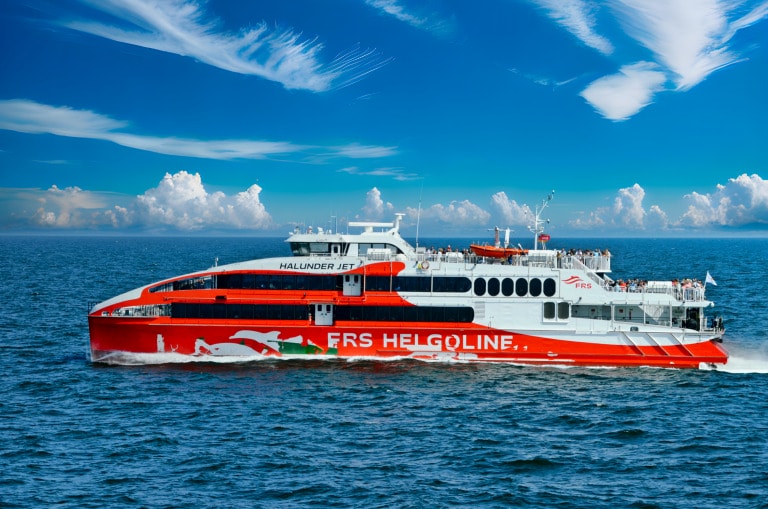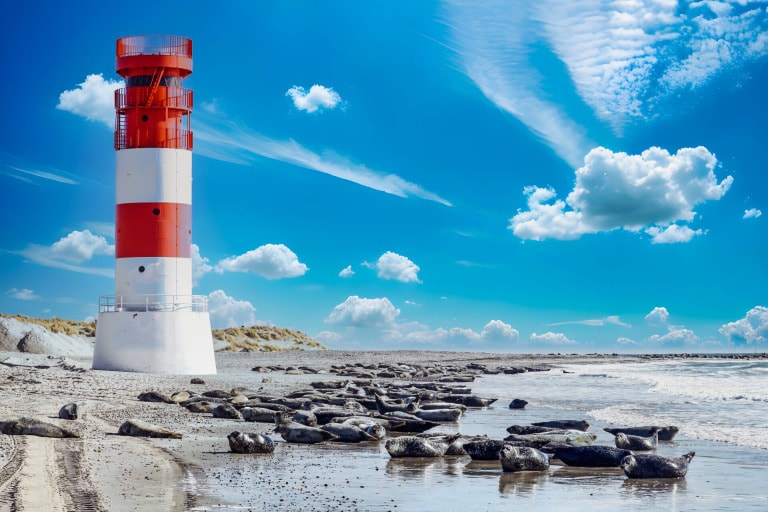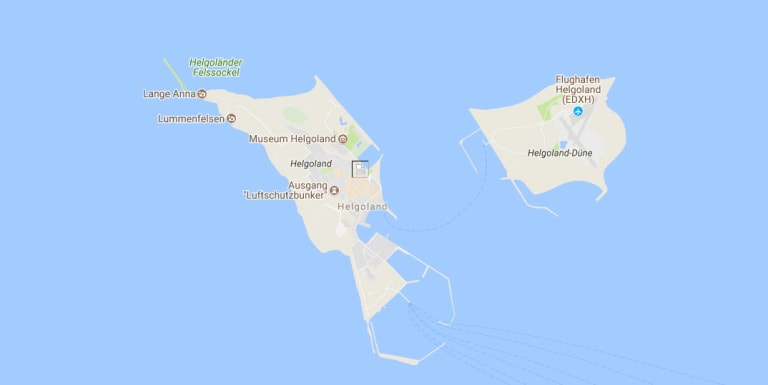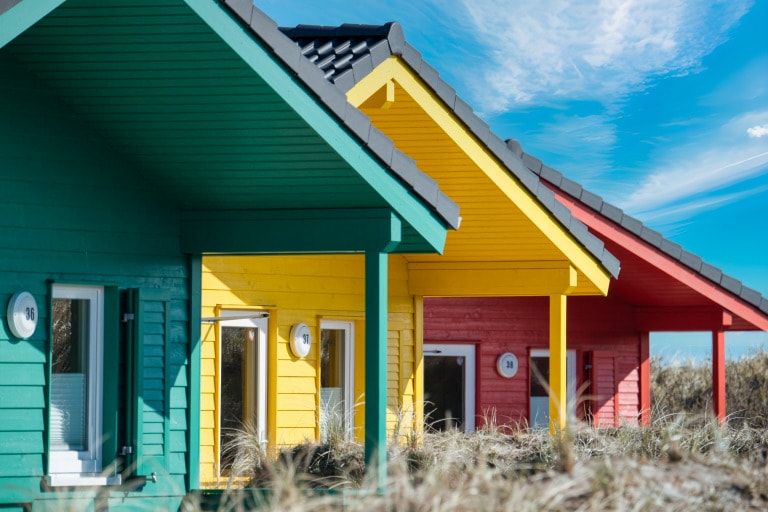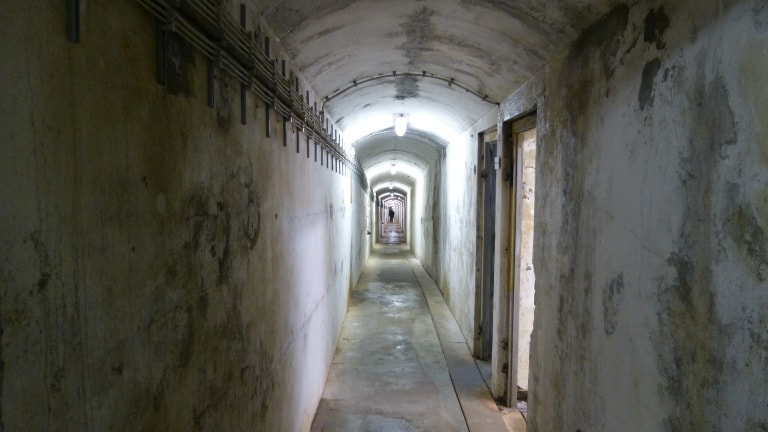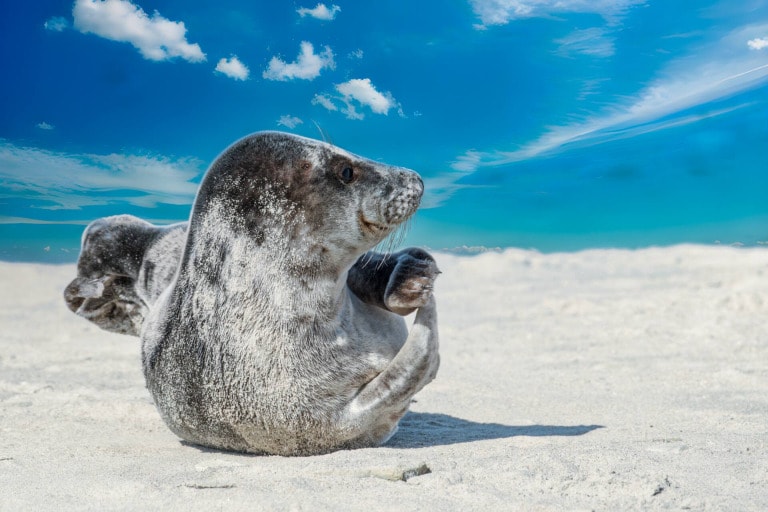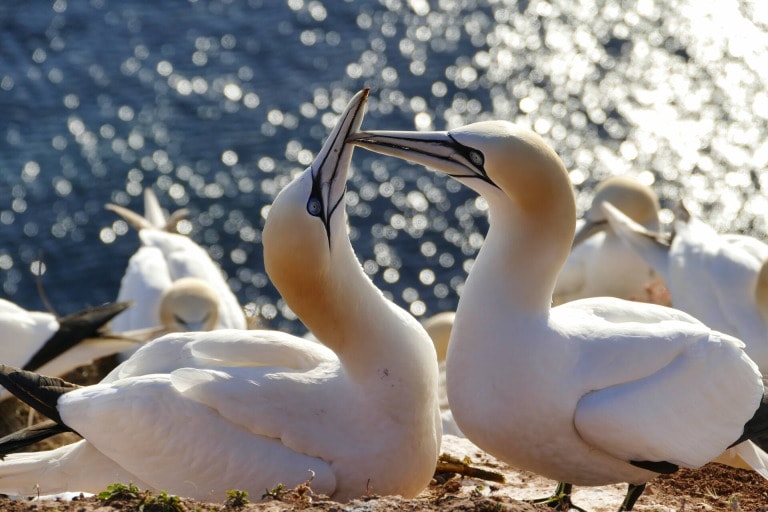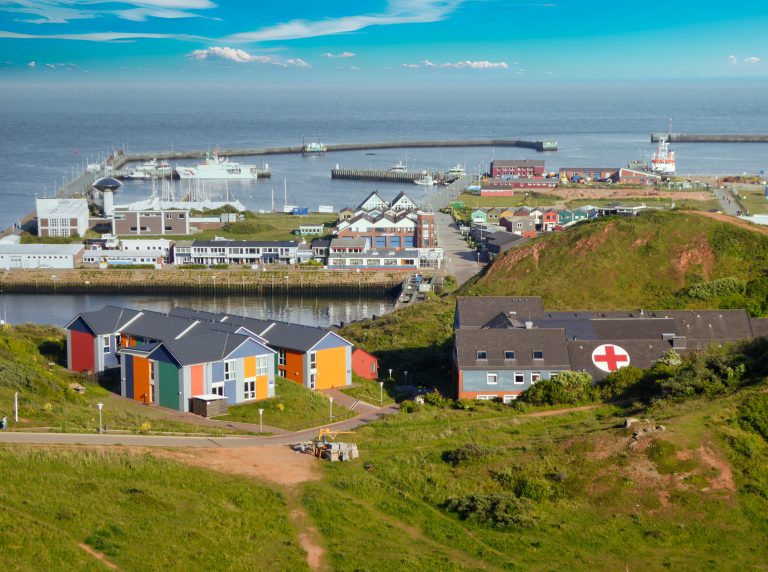Heligoland measures barely more than one square kilometer, but has for a North Sea vacation so many Sights to offer:
Wonderful natural spectacles, thousands of seabirds that have chosen the island of red sandstone as their nesting place, the cheerful buzz of voices when disembarking from the Börte boats, the spicy North Sea air and the steady rolling of the waves.
Life on Heligoland takes place on three levels:
Lower, Middle and Upper Country.
A walk around the Oberland on the 2.8-kilometer cliff path offers a fascinating view over the North Sea. 184 steps counts the staircase from the lower part of the Heligoland island to the Oberland. Those who shy away from the long staircase can reach their destination in a few seconds by elevator.
Thousands of day visitors come to the island to shop VAT-free. However, the character of the island is only revealed during a North Sea vacation of several days. It gives the opportunity to explore Helgoland's eventful history, to take the ferry to the dune and pay a visit to the now rare cone seals or to hike around the 47-meter high Lange Anna.
Those who love the North Sea beach will find a wonderful bathing paradise on the dune, which is not crowded at all.
Bunkers on Helgoland
During World War II, the island of Helgoland was converted into an offshore bunker. The interconnected tunnels under the Oberland provided shelter for more than 2,000 people when British bombers dropped more than a thousand bombs on April 18, 1945, over the North Sea island dropped. Hardly any house withstood them. The people, however, survived in the bunker.
350 meters of the tunnel are still preserved today and give vacationers and tourists an impression of Helgoland's eventful history.
90 steps lead down into the bunker. On the walls of the long corridors are simple wooden benches. On them, each islander was assigned a place of 50 centimeters. This was accompanied by a gas mask and an eating utensil. People had to hold out in the bunker for two days. Then the air raids were over and they had to realize that their home had become uninhabitable. The islanders had to leave Helgoland.
The British used the deserted island as a target for bombing exercises for seven years.
Heligoland lighthouse
The lighthouse on the upper land of the main island is one of the most famous Helgoland Sights. It tells about the serious past of the island and was built during the Second World War as an anti-aircraft tower. In 1952 it began to operate as a lighthouse, replacing the lighthouse from 1811, which was destroyed in the bombing days. The lighthouse is 35 meters high and stands 85 meters above sea level.
Today, the lighthouse on Helgoland has the strongest beacon on the German coasts. Even at a distance of almost 35 nautical miles, it shows ships the way through the German Bight. The beacon is visible on clear nights up to the East Frisian Islands clearly visible.
In the lighthouse there is a nuclear bunker, which was built during the Cold War.
A second lighthouse is located on the side island of Düne. It was built in 1936 from prefabricated steel parts and, after several modernizations, has been controlled from the main island for 35 years.
The lobster stalls
The Hummerbuden were once the living quarters, workshop and sheds of the fishermen of Helgoland. In 1952, after the resettlement of the island, the Hamburg architect Georg Wellhausen designed the new Hummerbuden.
Their style corresponds to the traditional models. Today, the colorful, two-story wooden cottages are used according to the motto 'Art, Culture and Knieper'. They form the promenade for tourists and locals in the harbor street of the Unterland. In addition to pubs, galleries, restaurants and tax-free stores, real rarities can be found in the lobster shacks.
Bude 31 offers handicrafts of a special kind: handmade jewelry made of red Helgoland rock. The Hallunder lovingly call it the Helgoland Diamond.
In the lobster shack 38/39 is a registry office where couples can meet in the North Sea vacation can give the yes-word.
Number 26 belongs to Detlev Rickmers' Hochsee Gallery. The associated restaurant houses the largest art collection in the world on the theme of Heligoland.
Tiiner-Bude serves kneepers, fish sandwiches and, in winter, delicious hot soups.
The Long Anna
The Lange Anna is t h e tourist attraction and landmark of Helgoland. The 47-meter-high surf pier in the northwest of the island is 47 meters high. It is formed by 25,000 tons of the red red sandstone characteristic of Helgoland and has a diameter of 180 square meters at the base.
Until 1860, Lange Anna, whose name, according to legend, comes from a beautiful Helgoland waitress, was part of a surf gate. A rock bridge connected it to the island. Since the bridge collapsed, the Lange Anna has been visible from afar, protected from the force of the waves by a wall, rising out of the sea.
The imposing natural monument is a breeding ground for many seabirds, including gannets and guillemots. The guillemots provide a special natural spectacle at dusk in June and July. Hundreds of the young birds, which are still unable to fly, leave the nest in the rocks and land in the North Sea. The so-called 'guillemot jump' can be observed from the cliff path.
Biological Institute Helgoland
The Biological Institute Helgoland is part of the Alfred Wegener Institute for Polar and Marine Research. The renowned research institute studies the ecosystem of the North Sea and its changes. Evaluations of research on Helgoland have shown that the waters of the North Sea have warmed by 1.1 °C over the last 40 years. The Helgoland Biological Institute has been able to demonstrate the decline of some species in the North Sea, such as cod and lobster.
An initiative of the institute serves the preservation of the blue Helgoland lobster. In a special breeding hall, small lobsters that have just hatched from their eggs are raised for a year. When the animals are about four centimeters in size, they are released into the wild on the Helgoland rock shelf. To support lobster rescue, the Biological Institute Helgoland "Lobster Sponsorships.
The aquarium of the institution is one of the most popular tourist attractions on the island. In 19 basins, it allows visitors to immerse themselves in the fascinating underwater world of the North Sea. A special visitor magnet is the arena tank, where sharks and rays live.
Museum Helgoland - Learn exciting things about Helgoland
The Helgoland Museum of Local History, founded in 1996, is one of the island's special attractions. Exciting exhibits tell about unique nature and history of Helgoland. The museum courtyard in the open-air area is full of colorful lobster stalls, which were modeled after the historical huts. The lobster shacks are dedicated to different themes.
The Franz Schensky exhibition shows pictures of the old Heligoland from the handover of the island to the German emperor in 1890 to the beginning of reconstruction in 1952.
A croft tells with valuable testimonies about the postal history of Helgoland under the direction of the Danes, the English and the Germans. The exhibition in another lobster shack is dedicated to the famous children's author James Krüss.
Special studio booths are made available to Helgoland artists on an annually changing basis.
The most famous exhibit of the museum is the Bronze Age 'Stone Box Helgoland' from the 16th century B.C. The box from a burial ground in the Oberland contained a skeleton, a golden ornamental needle and a dagger as grave goods. A replica of the stone cist can be admired in front of the Helgoland Museum.
St. Nicolai Church
The Evangelical Lutheran St. Nicolai Church in Helgoland's Oberland is a tourist magnet not only during Sunday services. It is dedicated to Nicholas of Myra, the saint of merchants and sailors. He had a very special meaning for the people of Helgoland. Thus, to this day, children on the island have a day off from school on St. Nicholas Day.
The church was built in 1952 on the site of the previous church destroyed in the war. Much of the equipment of the first church could be taken over into the new building. Among them is a gilded communion cup from 1705, decorated with a foot from the Middle Ages and ornate ornaments.
The nautical tradition is evident not only in the interior of the church. The wind vane on the bronze top of the church tower has the shape of a sailboat. The ringing of St. Nicolai, which until then consisted of only one steel bell, was expanded by five bronze bells in 1959.
The church of St. Nicolai on Helgoland has been elevated to the rank of a European cultural monument of special significance.
Aquarium Helgoland
The seawater aquarium is one of the tourist highlights on Helgoland. The attraction, which is over a hundred years old, is part of the Biological Institute on the high seas island. It presents the underwater flora and fauna of the southern North Sea. The aquarium's 19 large, glass tanks hold 300 cubic meters of seawater and are the habitat of more than 60 animal and plant species. They are kept as close to nature as possible, and not just for scientific purposes. This also includes seasonal temperature fluctuations.
The basins are the only marine aquarium in Germany to be filled naturally. The North Sea water from the Helgoland Reede reaches the basins directly via an 800-meter-long pipeline. Sturgeons, cat sharks, spider crabs, impressive rays and the now rare Helgoland blue lobster find valuable food particles in the fresh seawater. They are joined by "invaders" from warmer regions: Sea bass and striped mullet.
Also worth seeing is the open-air pool of the aquarium, where seals from the breeding of the Biological Institute Helgoland cavort.
Finally, the Aquarium Helgoland offers changing marine biology exhibitions.
Cliff Edge Trail
With a height of 62 meters, the red red sandstone cliff of Helgoland is the highest elevation in the district of Pinneberg in Schleswig-Holstein. The cliff edge path leads with 2.8 kilometers around the upper land of the island, which can be reached via 184 steps or a practical lift. In addition to a fantastic panoramic view over the North Sea, walkers can enjoy the view of the lower land with its colorful lobster stalls, the dune and the harbor. The numbers on the path reveal how many meters of the cliff edge walk have already been covered.
Numerous benches along the way invite you to observe seals, ships and countless seabirds. Soon Lange Anna comes into view, heralded by the cries of the gannets. Hundreds of them populate the imposing rock. A few meters further on, a stairway leads up to the natural North Beach of Heligoland.
Arriving at the end of the cliff edge trail, the hiker marvels at the artistic skills of sheep grazing on the meadows of the uplands. In the process, they come breathtakingly close to the cliffs.
Allotment gardens on Helgoland
There are 75 allotment gardens on Helgoland with a magical view of the North Sea and the neighboring bathing dune. Hard to believe, but Helgoland chronicles testify that already in 1697 grain and potatoes were grown on the island of sandstone. Pastures for cows, horses and sheep also existed at that time. While the men went to sea, it was the women's job to contribute to the family's food in this way.
After the resettlement of Helgoland in 1952, the establishment of allotment gardens was also intended to provide food. The Hallunders grew potatoes, peas and cabbage. Today, traditional kale, soft fruit, rhubarb and herbs dominate the picture of allotment gardens on Helgoland. In addition, there are splendid ornamental gardens with magnificent roses and other flowers.
Not only the allotment gardeners enjoy the pretty gardens in a picturesque location. They are a real Helgoland sight for tourists on their tour around the Oberland on the Klippenrandweg.
Lummen rock on Helgoland
The Lummenfelsen of Helgoland is with 1.1 hectares the smallest nature reserve in Schleswig-Holstein and Germany. But there are more breeding birds here than anywhere else. The cliff edge path in the uplands leads past the Lange Anna directly to the bird paradise.
The guillemot rock is the only German breeding ground for kittiwake, razorbill and guillemot. The bird sanctuary is managed by the 'Jordsand' association. Its ornithologists provide on-site information about the bird species and their way of life.
A special attraction is the so-called 'guillemot jump' at the end of June to the beginning of July. The still flightless young birds of the guillemot then leave the breeding nests in the rocks in their hundreds at dusk and dare a daring jump into the North Sea. A unique sight that can only be observed on the high seas island of Helgoland.
In the places of the cliffs inaccessible to the sheep, you can find the cliff cabbage, otherwise unknown in Germany, which blooms in rich yellow in the spring. It is a wild form of our vegetable cabbage.
Hoffmann von Fallersleben Monument
In the lower part of the island of Helgoland, at the jetty of the Börte boats, there is a monument to the German poet August Heinrich Hoffmann von Fallersleben. On August 26, 1841, Hoffmann von Fallersleben wrote the 'Song of the Germans' on Helgoland, the third stanza of which is still the text of our country's national anthem.
The bronze bust by the Berlin sculptor Schaper from 1902 stands on a simple stone pedestal. In addition to the poet's life data and the note that he wrote the 'Song of the Germans' on Helgoland, the verses 'Einigkeit und Recht und Freiheit sind des Glückes Unterpfand' (Unity and Law and Freedom are the Pledge of Happiness) are quoted engraved in the base.
The poem is said to have been written in the evening after a merry men's round and to have contained various toasts in its first version. The poet sold the text for 4 louis d'or to his publisher Campe, who added the music of Haydn's song 'Gott erhalte Franz den Kaiser'. The first performance took place in Hamburg on October 5, 1841, in the presence of Hoffmann von Fallersleben.
More information
The approximately 1,400 'Hallunder' are very hospitable and happy to talk about their lives in the middle of the North Sea. In the evenings, hotels and small restaurants invite you to enjoy a fine dinner with freshly caught sea fish, lobster or knieper. The claws of the crab are a particularly tasty Helgoland specialty.
Every season offers very special sights on the high seas island of Helgoland. In addition, there is - statistically proven - much more sunshine than on the mainland.
In spring, seagulls and the funny guillemots build their nests. In addition, the early Klippenkohl blossoms yellow. In summer, Helgoland with its wide natural beaches on the dune turns into a wonderful bathing paradise. Fishing boats invite you to go cod fishing, and neither islanders nor vacationers want to miss the magnificent sunset at Helgoland's northern tip.
Autumn on Helgoland is the ideal time for rest and relaxation in the middle of the North Sea. The main island and dune entice visitors to take hearty hikes on the cliffs and beach. Countless migratory birds, which rest on the island in flocks, provide an impressive backdrop. In the evening, a Helgoland egg grog warms body and soul. In winter, no babble of voices disturbs the sound of the sea. Nevertheless, even at this time of year Helgoland is not deserted, but full of tourist attractions.
The heated seawater swimming pool attracts bathing and swimming. Stores and boutiques are open for VAT and duty free shopping. During Advent, the Christmas market 'Hummerbudenzauber' smells of mulled wine and delicious things. The illumination of Helgoland's rock grottoes is particularly impressive during the Christmas season.


